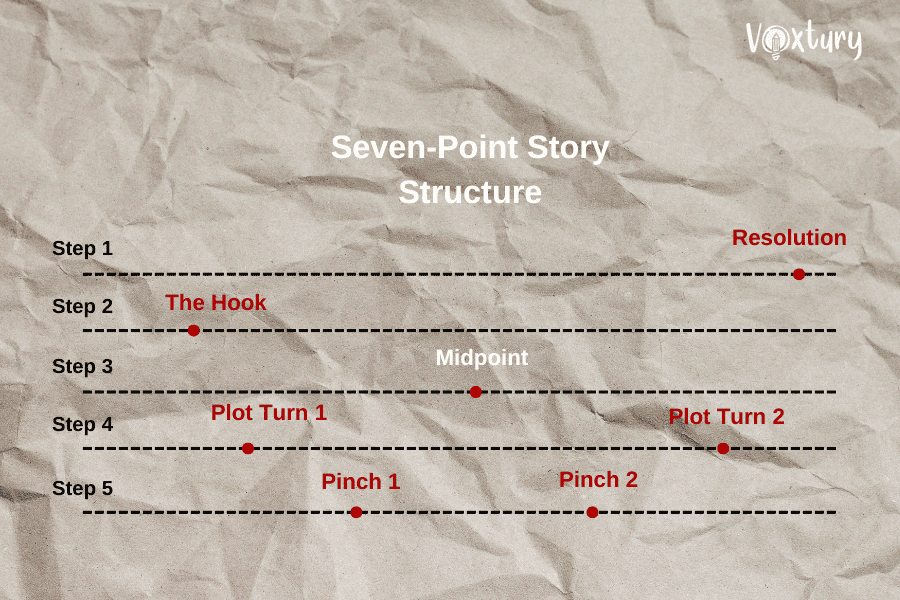Before you start writing your novel, you need to come up with a structure and main events – otherwise, it’s very easy to get lost and steer away from the initial idea, leading to a rather messy plot. While the three-act story structure is a common way to do it, if you really want to get into the plot of the story, the 7-act story structure is a significantly better option. But what is it, and what does it entail? That’s what we’ll focus on below.
Key Highlights
- A 7-act story structure is a detailed framework that breaks a story into seven sequential events, ensuring clarity, character development, and strong pacing across any genre.
- As the name suggests, it is made up of seven points: Hook (captures attention, introduces characters and setting), Plot Point 1 (Inciting event triggers the main conflict), Pinch Point 1 (Introduces antagonist or a major challenge), Midpoint (Protagonist becomes active and takes control), Pinch Point 2 (Protagonist hits rock bottom, facing despair), Plot Point 2 (Key discovery helps resolve the conflict), Resolution (Climax and conclusion tie up loose ends).
- There are many reasons why authors use it, but the main ones are that it keeps the audience entertained, it supports in-depth character development, and it’s not limited to one genre or medium.
- There are several mistakes you can make when using the seven-act story structure, including uneven pacing, weak resolution, or lacking momentum.
What Is a Seven-Act Story Structure?

With a seven-act story structure, also known as a seven-point plot structure, you map out seven sequential events within a story, which you will later use as a guide. Regardless of what genre it is part of or what your story talks about, there are certain elements that will be present either way – the seven-act structure outlines them and helps you better navigate the plot once you sit down to do the actual writing.
Why Use Seven Point Plot Structure
You might be wondering – Why should I use a seven act story structure when writing my book? There are a few reasons, but the main ones include:
- In-depth character development – Using this structure allows the author to deeper explore character arcs and relationships.
- Builds tension – Seven point plot structure ensures that the conflict escalates consistently, with multiple turning points. Each new act introduces new challenges and resolutions, driving the narrative forward.
- Can be used with various genres and mediums – The seven-point plot structure works in all kinds of settings and can be used across a variety of genres and mediums, including books, movies, TV shows, and video games.
The Seven Point Structure Explained
Let’s go through each element of the seven-point structure, explaining its purpose and what it involves.
- The Hook
This is the first element of the seven-act story structure. Its purpose is to introduce the characters and setting, capture the reader’s attention, and explain the premise of the story, giving them insight into what will happen in the upcoming chapters.
- Plot Point 1
This is when the action actually starts – a surprising or unusual event taking place triggers the commencement of the story and sets it in motion.
- Pinch Point 1
This is when a major change is introduced into the story, either by adding an antagonist or introducing a challenge or a conflict.
- Midpoint
In the midpoint, the main character stops being a passive participant and transforms into an active one, actually taking action with a clear goal in mind and a plan for how to achieve it.
- Pinch Point 2
In the second pinch point, the protagonist reaches rock bottom – they feel like things cannot get worse and are losing all hope that it will get better.
- Plot Point 2
During the second plot point, the main character learns something that brings them closer to resolving the conflict or defeating the antagonist.
- Resolution
The conclusion of the story during which the antagonist is defeated, and the conflict is resolved.
Tips for Writing a Seven-Point Plot Structure
Here are some helpful tips for coming up with a seven-act point structure:
- Work from the end and make your way to the start. The best way to go about writing a book when using the seven-point plot structure is to start from the resolution, as it will provide your story with a clear direction.
- Write a compelling hook. As the first element of this structure, the hook is crucial – pay special attention to it, as it needs to grab the reader’s attention.
- Focus on crafting complex antagonists. Forget about the classic good vs bad – instead, create antagonists that have complex motivations, believable flaws, and struggle with inner conflicts.
- Let the story progress slowly rather than sharing everything from the start. Don’t overwhelm the reader with conflict from the start. Introduce challenges gradually, increasing the intensity as the story progresses.
- Don’t only focus on the plot, showcase emotions as well. Sensory details, vivid descriptions, and emotional language, as well as focus on what the character is feeling in a given moment is crucial to fully convey the message to the reader.
Common Mistakes to Avoid
There are several mistakes that you can make when using a 7-act structure for your story, especially if you’re doing it for the first time – and we’ll explore some of them here.
Uneven Pacing
When writing a book using a 7-act plot structure, it’s important to get the pacing right. It’s actually easy to unintentionally make one part of the story significantly shorter than the rest, making it seem rushed.
Using short acts in the whole story can make you miss out on the important plot points, and the plot might feel underdeveloped. On the other hand, doing the opposite, so using long acts throughout your whole story, can make the reader lose interest in it and unless you do it right, it might feel repetitive or slow.
Another mistake you can make is the lack of clear turning points. Whenever the story is moving in a new direction, you need to make it clear to your readers why that’s happening – otherwise, you risk confusing them.
Weak Resolution
Another common mistake you can make is crafting a conclusion that does not provide closure – either by not addressing certain plot holes or neglecting key character arcs. The solution to a conflict might also feel unearned and as if it came out of nowhere. While, depending on the plot, some ambiguity is welcomed, generally speaking, you should make sure that the final act of your story ties up loose ends.
Lacking Momentum
The middle acts are some of the hardest parts to write, as you need to make sure that you’re keeping up the tension and the content is engaging. Otherwise, the sections might feel repetitive or meandering if they don’t introduce anything new to the story, do not provide your main character with some new challenges, or do not deepen the character stakes.
Examples of 7-Act Structure

Lord of the Rings – J.R.R. Tolkien
- The Hook: Frodo enjoys a peaceful life in the Shire, an idyllic, sheltered world. The presence of the One Ring hints at an impending conflict.
- Plot Point 1: Gandalf reveals the Ring’s power and Sauron’s pursuit. Frodo must leave the Shire, setting the journey into motion.
- Pinch Point 1: The Black Riders relentlessly pursue Frodo, showing the stakes and danger of his mission. Frodo realizes the journey is far more perilous than expected.
- Midpoint: Frodo chooses to bear the Ring alone after Boromir’s moment of weakness. He takes active control of the mission, fully committing to destroying the Ring.
- Pinch Point 2: Frodo and Sam reach Mordor, exhausted and despairing. Frodo’s spirit is almost crushed by the burden of the Ring, and Gollum betrays them.
- Plot Point 2: Sam rescues Frodo from Shelob’s lair. They press on together with renewed determination to reach Mount Doom.
- Resolution: Frodo and Sam destroy the Ring (with Gollum’s unwitting help). Sauron is defeated, and Middle-earth is saved.
The Hunger Games (Book 1) – Suzanne Collins
- The Hook: Katniss Everdeen, a skilled but struggling teenager in District 12, hunts to provide for her family in a dystopian world where the Capitol oppresses the districts. The Hunger Games are introduced as an annual, deadly competition that has been going on for generations.
- Plot Point 1: Katniss volunteers to take her younger sister Prim’s place in the Hunger Games. This unexpected act of love sets the main story into motion.
- Pinch Point 1: The Capitol looms as the antagonist, and the training period reveals the overwhelming odds Katniss faces against other skilled tributes. She and Peeta must navigate public perception to gain sponsors.
- Midpoint: The Games begin. Katniss transforms from a passive player to an active one, setting traps and surviving on her wits while maintaining her focus on staying alive. She forms an alliance with Rue, a girl who’s been shadowing her since the training period and who reminds her of her sister, Prim.
- Pinch Point 2: Rue is killed, leaving Katniss devastated and more determined to challenge the Capitol’s cruelty. She feels the hopelessness of the Games’ brutality and her limited power against it.
- Plot Point 2: Katniss and Peeta learn that two tributes from the same district can win if they team up. They form a partnership, increasing their chances while deepening their bond.
- Resolution: Katniss outwits the Capitol by threatening a double suicide with poisonous berries. She and Peeta are crowned joint victors, but her defiance plants the seeds of rebellion, setting the stage for future conflict.
The Bottom Line
The 7-act structure is a common way of planning a story and is present in many popular works, Lord of the Rings and The Hunger Games being just two examples. It’s actually one of several beneficial tools that can be useful when writing your own narrative – there are plenty of them for each stage of the book writing process.
At Voxtury, we understand that if you can, you should utilize whatever resources you can to make the writing process easier. That’s why we created our online editor – a tool that helps you improve the final product by highlighting typos, repetitions, and more.
Wanna learn more about the theoretical side of book writing, book publishing, or book promoting? Don’t hesitate to take a look at our sections dedicated to both.